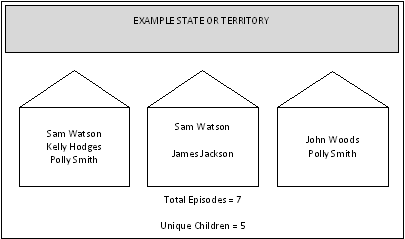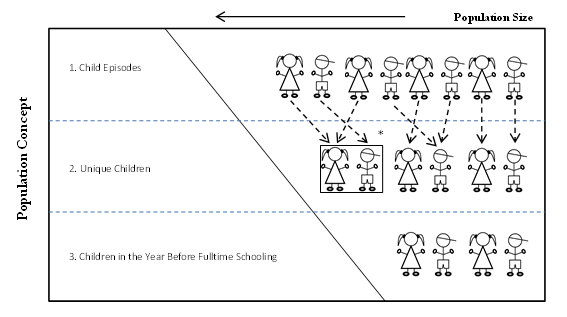CHILD COUNTING CONCEPTS
This section describes the key child counting concepts used in the 2013 Collection. Further supporting terms and definitions are provided in the Glossary.
EPISODE
An episode is the count of a single occurrence of a child attending a preschool program. When a child attends two different preschool programs, this is described as a child attending two episodes of preschool. For this reason, the concept of child episode produces the largest count of observations.
CHILD
The count of children represents the count of unique children, irrespective of the number of separate preschool episodes any one child may receive. When a child attends two different preschool programs, the child will only be counted once where unit record level information is available to support this. In any given collection year, the number of unique children will be less than the number of child episodes. These concepts are further demonstrated in Figure 3.6 below.
In Figure 3.6, there are 7 separate episodes of preschool but 5 unique children in preschool. Sam Watson and Polly Smith both attend two different service providers where they receive two separate episodes of preschool. James Jackson, Kelly Hodges and John Woods each experience only one episode of preschool. See the Glossary, for further information on the concept of an ‘episode’.
Figure 3.6 Relationship of Episode counts and Child counts

YEAR BEFORE FULL-TIME SCHOOLING
The YBFS, (also referred to as the 'year before formal schooling') is a concept used to describe the 'preschool cohort’ of children who are in the year before commencing full-time schooling. Despite the varying delivery models of early childhood education across jurisdictions (McEwin and Ryan, 2009), the year before a child begins full-time schooling may be conceptualised as Year 1 (or Grade 1) minus 2 years, or Foundation year (national curriculum) minus 1 year. This cohort may be a combination of children aged 3, 4, 5 and sometimes 6 years old. However, for the purposes of the Collection counts of children in the YBFS cohort are reported for children aged 4 and 5 only.
Children who are 5 or 6 years old and attending a preschool program have usually attended more than one year of a preschool program, or may have been delayed from starting preschool at the usual age. The 3 year old children include those that are eligible for early entry due to special needs or giftedness, or who will attend the first year of full-time schooling as four year old children due to certain state or territory school starting age exemptions. Children eligible for early entry to preschool aged 3 years and who remain for a second year of preschool as children aged 4 years (e.g. early entry for Aboriginal and Torres Strait Islander children or children with special needs), are in the YBFS cohort when they attend preschool as 4 year old children.
Operationally for the Collection, children were only included in the YBFS cohort if the child was 4 or 5 years old. To be included as a 5 year old, the child record must have been supplied with a preschool repeater indicator flagged in the negative. Five year old children with a repeater indicator flagged in the affirmative were excluded within the YBFS population. Refer to Figure 3.12 Creating a Unique Child Record for the Year Before Full-time Schooling Concept.
Unique child counts produce fewer totals than episodes as this population counts each child only once, irrespective of the number of preschool episodes they have received during the reference period. This population includes instances of children who are enrolled in a preschool program across multiple years, that is, they will be counted in both the 2012 and 2013 collections if they were enrolled in a preschool program and attended the preschool program for at least one hour during the reference period.
YBFS counts of children produce even lower totals than unique children as the count removes children aged 5 or 6 years old who undertook preschool in the previous year as these children would have been included in the 2012 YBFS counts. This population includes 4 and 5 year olds who are enrolled in their first year of a preschool program.
Figure 3.7 below depicts the impact on population size in relation to the logic associated with each of the 3 population counting concepts. A unique child can have more than one episode of preschool during the reference week. The number of episode counts will be higher than the number of unique child counts, which in turn will be greater than the number of children in the YBFS.
Figure 3.7 Counting Concepts on population size

* Excluded from the current cycle YBFS counts since were included in the previous cycle YBFS count.
 Print Page
Print Page
 Print All
Print All